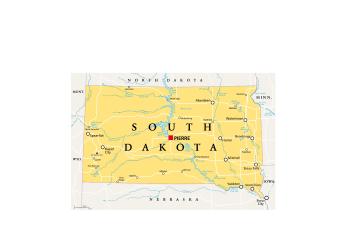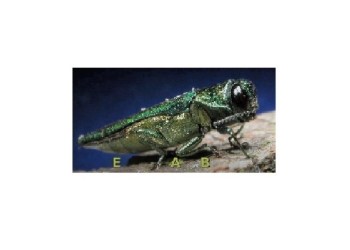Plants
The plant life of the Dakota Prairie Grasslands features a diverse ecosystem, which is dominated by native grasses and forbs. Certain areas have woody plants, including trees and shrubs. The growing season on the Grasslands spans from April through October providing an opportunity to see the vast prairie elements. Before you go, visit the Animals and Plants page and download the Plant and Wildlife Checklist to help keep track of the flora and fauna you may spot in the grasslands.
Shortgrass Prairie
Figure 1. Blue Grama (Bouteloua gracilis)
A native, warm-season, short grass known for its fine, blue-gray foliage and distinctive, curved seed heads that resemble eyebrows, making it a drought-tolerant. It's a dominant species in the shortgrass prairie ecosystems of North America.
(USDA Forest Service photo by Stacy Swenson.)Short grasses are mostly found in the western, unglaciated parts of North Dakota, often on rolling plains with some buttes or badlands formations, such as the Little Missouri National Grasslands. The shortgrass prairie is characterized by its semi-arid climate, short-to mid-height grasses, and Forbs (flowering plants) that survive on limited moisture.
Dominant grasses include blue grama (Figure 1), buffalo grass, and threadleaf sedge. These species also occur in the mixed prairies of the National Grasslands, including those along the Grand River, Cedar River, and Little Missouri.
Shortgrass prairie provides essential habitat and resources for various animals, supporting grazing herbivores and their predators. The grasses serve as a primary food source for species like prairie dogs, pronghorn, and various birds, including the Western meadowlark and the burrowing owl.
Tall Grass Prairies
Figure 2. Big Bluestem (Andropogon gerardii).
A tall, warm-season grass known for its blue-green foliage in the spring and summer, which turns reddish-bronze in the fall. The grass has a distinctive flower head that resembles a turkey foot.
(Licensed photo by Jennifer/Adobe Stock photo.)Tallgrass prairie is a diverse ecosystem dominated by tall, native grasses, with a variety of forbs (flowering plants). It is characterized by flat or rolling terrain, fertile soils, and moderate rainfall. Tallgrass prairie soils are typically deep and dark with a thick topsoil of rich organic matter formed from the decomposition of deep-rooted grasses.
Dominant grasses include Big Bluestem (Figure 2), Little Bluestem, lndiangrass, Switchgrass, Prairie Cordgrass, and Side-oats grama. Various animals, including large grazing mammals like deer, insects, amphibians, reptiles, and numerous grassland birds such as the greater prairie chicken, call tallgrass prairies home.
The Sheyenne National Grassland is the only National Grassland located in the tallgrass prairie ecosystem in the United States. Because of the fertile soils, much of the tallgrass prairie region was converted to agriculture production and today, less than 4% of the tallgrass prairie that once covered North America remains.
Mixed-grass Prairie
Figure 3. Needleleaf Sedge (Carex duriuscula).
A perennial, grass-like plant with slender, three-sided stems and needle-like leaves that grow up to two to eight inches tall, often found in prairies, rock outcrops, and sandy riverbanks.
(USDA Forest Service photo. )Mixed-grass prairie is characterized by a mix of tall, mid, and short grasses and a rich variety of forbs (flowering plants). Healthy mixed-grass prairie soil is fertile and resistant to erosion, thanks to the strong root systems of prairie grasses.
Prevalent grass species include Western Wheatgrass, Needle-and-thread, Blue grama, Little Bluestem, and Needleleaf sedge (Figure 3). Mixed-grass prairies support a diverse array of wildlife, including mule deer, coyotes, and sharp-tailed grouse.
Mixed-grass prairie is found in the central and western parts of North and South Dakota. It represents an
ecotone where the species composition shifts between the tall and short grass prairie types. The Grand River, Cedar River, Sheyenne, and Little Missouri National Grasslands all have areas with mixed-grass prairie.
Warm-season Grasses
Figure 4. Switchgrass (Panicum virgatum).
A tall, clump-forming, warm-season perennial grass that grows three to seven feet tall, with finely textured flower panicles, which can be reddish-purple and turn golden in the fall.
(Licensed photo by Winfried Rusch/Adobe Stock photo.)Warm-season grasses are a key part of the prairie ecosystem. These grasses thrive during the warmer
months of the year, typically from early to late summer, and are well-suited to the hot, dry conditions of the Great Plains. Many of them grow in a bunch-grass growth form, providing both open ground for wildlife movement and overhead cover.
Examples of common warm-season grasses on the Dakota Prairie Grasslands include switchgrass (Figure 4), Indiangrass, big bluestem, little bluestem, and blue grama.
Cool-season Grasses
Figure 5. Needle-and-Thread Grass (Hesperostipa comata).
A native cool-season, perennial bunch grass characterized by its long, spiraling, hairy awns (threads) that emerge from the top of the seed heads (needles) that grows to a height of one to four feet tall.
(USDA Forest Service photo. )Cool-season grasses thrive during the spring and fall months when temperatures are cooler and there is more moisture. They are adapted to the region's climate with large temperature fluctuations and become less active in the summer due to high temperatures and lower precipitation; however, their growth resumes in the fall when temperatures drop. They can thrive in various soil conditions, from shallow to deep and moderately coarse to fine textured, as long as the soil is moderately well to
well-drained.
Grasses like western wheatgrass (both North and South Dakota's state grass), green needlegrass, and needle-and thread grass (Figure 5) are examples of cool-season grasses.
Gallery of Grasses in the Grasslands
Click an image to view the photo gallery in full-screen size and read the descriptive captions.
Wildflowers in the Grasslands
The prairie ecosystem features various wildflowers (forbs) that draw flower lovers and pollinators alike. The wild prairie rose (North Dakota state flower), American pasque flower (South Dakota state flower), various goldenrods, black-eyed Susan, Western prairie fringed orchid, and many other native species can be found across the Dakota Prairie Grasslands.
Click an image to view the photo gallery in full-screen size and read descriptive captions.
The Western Prairie Fringed Orchid
Figure 6. Western Prairie Fringed Orchids are primarily pollinated by sphinx moths, attracted by its strong, fragrant scent and nectar, which is located in a long spur. While reaching for the nectar, they transfer pollen from flower to flower, aiding in the orchid's reproduction.
(USDA Forest Service photo. )The Western Prairie Fringed Orchid (Platanthera praeclara) (Figure 6) is a unique and beautiful plant
species known for its large, creamy white blossoms that form an open, spike-like arrangement at the top of the stem with fringed lower petals. The orchid has a single, smooth stem with alternate leaves that grow from a fleshy, tuberous root. Its height ranges from 15 to 33 inches, and it can bear up to two dozen or more flowers. The orchid emerges in May and blooms in July. It requires direct sunlight for growth and is found in moist tallgrass prairie and sedge meadows.
At night, large sphinx moths pollinate their fragrant flowers. A video of the sphinx moth pollinating the orchid is available here.
The western prairie fringed orchid is federally protected under the Endangered Species Act as a threatened species. Due to their protection, please never pick these flowers! One of the largest remaining populations of the orchid occurs on the Sheyenne National Grassland. During the early weeks of July, it can be spotted in the ditches along ND Highway 27 within the Sheyenne National Grassland.
Woody Plants in the Grasslands
Various Trees and Shrubs
Woody plants, including trees and shrubs, are generally less common in the Dakota Prairie Grasslands than grasses and forbs. However, they are still present, particularly along riverbanks, in protected areas, and where the prairie transitions into woodlands.
Click an image to view the photo gallery in full-screen size and read descriptive captions.
Invasive Species
An invasive species is non-native to the ecosystem it occupies, and its existence in that ecosystem causes or is likely to cause harm to the economy, environment, or human health. Invasive species can be plants, animals, algae, fungi, or disease-causing microorganisms. These harmful invaders can threaten aquatic and terrestrial ecosystems if left unchecked.
Invasive Grasses
In the Dakota Prairie Grasslands, invasive grasses such as Kentucky bluegrass, Smooth brome, and crested wheatgrass can outcompete native species, reducing biodiversity and wildlife habitat.
Click an image to view the photo gallery in full-screen size and read the descriptive captions.
Invasive Trees and Shrubs
Rocky Mountain juniper is a native species that was naturally kept in check with wildfire but is now considered invasive as it expands across the prairie landscape. Juniper was traditionally associated with north-facing draws and near butte summits in the badlands on the Little Missouri National Grassland. It can outcompete native grasses for water and nutrients, changing the prairie's vegetation structure. Other invasive trees or shrubs found on the Dakota Prairie Grasslands include Russian olive, buckthorn, smooth sumac, and eastern red cedar.
Click an image to view the photo gallery in full-screen size and read descriptive captions.
Noxious Weeds
A noxious weed is a weed that an agricultural or other governing authority has designated as a plant harmful to agricultural or horticultural crops, natural habitats or ecosystems, or humans or livestock. There are several common noxious weeds found on the Dakota Prairie Grasslands, including leafy spurge, Canada thistle, and Absinthe wormwood. Noxious weeds are treated on the Grasslands with various methods, including biocontrol, livestock grazing, mechanical methods, and herbicide treatments.
South Dakota Noxious Weeds

For noxious weeds in South Dakota, visit the South Dakota University Extension site.
North Dakota Noxious Weeds

For noxious weeds in North Dakota, visit the North Dakota Department of Agriculture site.
The Emerald Ash Borer
Figure 7. A highly magnified direct head-on image of the emerald ash borer.
(Licensed photo by Macroscopic Solution/Adobe Stock photo. )The Emerald Ash Borer (EAB) (Agrilus planipennis) (Figure 7) is a destructive wood-boring winged beetle that feeds on and kills ash trees. Currently there are no known locations of EAB on the Dakota Prairie
Grasslands, but it is a threat to the green ash found along rivers, streams and woody draws across the
Grasslands.
EAB has been reported in both North and South Dakota. North Dakota is estimated to have around 90 million ash trees, the state's most abundant forest land tree species. South Dakota's green ash population accounts for 21% of its hardwood biomass.
Contact the local Ranger District Office for more information or to report an EAB sighting.
DON'T MOVE FIREWOOD! The most common way EAB and other wood pests spread is through the movement of infested firewood, logs, branches, nursery stock, chips, or other products. By moving infested wood, people inadvertently transport pests to new areas, accelerating the spread of the pest.
Click an image to view the photo gallery in full-screen size and read the descriptive captions.
Protect North Dakota from the Emerald Ash Borer

The NDSU Extension video discusses the Emerald Ash Borer (EAB) and its potential impact on North Dakota.



























































